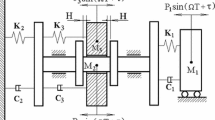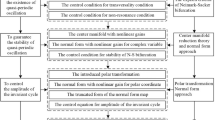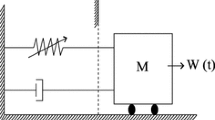Abstract
Under the suitable parameter combination, the vibro-impact system with symmetry exhibits symmetric quasi-periodic motions in the vicinity of Neimark–Sacker bifurcation (i.e., NS bifurcation) point satisfying 1:2 resonant conditions and double Neimark–Sacker bifurcation (i.e., NS–NS bifurcation) point. Based on the fact that the Poincaré map P is the second iteration of another virtual implicit map Q, the coexistence and symmetry of the attractor of the Poincaré map is discussed by means of the limit set theory. The map Q can capture two conjugate limit sets and hence can capture two conjugate quasi-periodic motions. Based on the Poincaré map, QR method is used to compute Lyapunov dimension, which can be used to characterize various quasi-periodic motions. Numerical simulation shows that the symmetric quasi-periodic motion can lose the stability and bifurcate into various subharmonic quasi-periodic motions via period-doubling bifurcation. Torus bifurcation of the symmetric quasi-periodic motion can also take place, which induces to a symmetric torus in the Poincaré section. Bifurcation of quasi-periodic motion will give birth to the coexistence of quasi-periodic motion. It is shown that all quasi-periodic attractors have at least a zero Lyapunov exponent, but various quasi-periodic attractors have different Lyapunov dimensions.







Similar content being viewed by others
References
Holmes, P.J.: The dynamics of repeated impacts with a sinusoidally vibrating table. J. Sound Vib. 84(2), 173–189 (1982)
Shaw, S.W.: Forced vibrations of a beam with one-sided amplitude constraint: theory and experiment. J. Sound Vib. 92(2), 199–212 (1985)
Whiston, G.S.: Global dynamics of a vibro-impacting linear oscillator. J. Sound Vib. 115(2), 303–319 (1987)
Luo, A.C.J.: Period-doubling induced chaotic motion in the LR model of a horizontal impact oscillator. Chaos Solitons Fractals 19, 823–839 (2004)
Luo, G.W., Xie, J.H.: Hopf bifurcation and chaos of a two-degree-of-freedom vibro-impact system in two strong resonance cases. Int. J. Non-Linear Mech. 37(1), 19–34 (2002)
Xie, J.H., Ding, W.C.: Hopf–Hopf bifurcation and invariant torus \(T^{2}\) of a vibro-impact system. Int. J. Non-Linear Mech. 40, 531–543 (2005)
Ding, W.C., Xie, J.H.: Dynamical analysis of a two-parameter family for a vibro-impact system in resonance cases. J. Sound Vib. 287, 101–115 (2005)
Yue, Y., Xie, J.H.: Neimark–Sacker-pitchfork bifurcation of the symmetric period fixed point of the Poincaré map in a three-degree-of-freedom vibro-impact system. Int. J. Non-Linear Mech. 48, 51–58 (2013)
Nordmark, A.B.: Non-periodic motion caused by grazing incidence in an impact oscillator. J. Sound Vib. 145(2), 279–297 (1991)
Mehran, K., Zahawi, B., Giaouris, D.: Investigation of the near-grazing behavior in hard-impact oscillators using model-based TS fuzzy approach. Nonlinear Dyn. 69, 1293–1309 (2012)
Kundu, S., Banerjee, S., Ing, J., Pavlovskaia, E., Wiercigroch, M.: Singularities in soft-impacting systems. Phys. D 241, 553–565 (2012)
Ma, Y., Ing, J., Banerjee, S., Wiercigroch, M., Pavlovskaia, E.: The nature of the normal form map for soft impacting systems. Int. J. Non-Linear Mech. 43, 504–513 (2008)
Chillingworth, D.R.J.: Dynamics of an impacting oscillator near a degenerate graze. Nonlinearity 23, 2723–2748 (2010)
Zhao, X., Dankowicz, H.: Unfolding degenerate grazing dynamics in impact actuators. Nonlinearity 19, 399–418 (2006)
Thota, P., Dankowicz, H.: Analysis of grazing bifurcations of quasiperiodic system attractors. Phys. D 220, 163–174 (2006)
Kryzhevich, S., Wiercigroch, M.: Topology of vibro-impact systems in the neighborhood of grazing. Phys. D 241, 1919–1931 (2012)
Du, Z.D., Li, Y.R., Shen, J., Zhang, W.N.: Impact oscillators with homoclinic orbit tangent to the wall. Phys. D 245, 19–33 (2013)
O’Connor, D., Luo, A.C.J.: On discontinuous dynamics of a freight train suspension system. Int. J. Bifurc. Chaos 12(24), 1450163 (2014)
Gan, C.B., Lei, H.: Stochastic dynamic analysis of a kind of vibro-impact system under multiple harmonic and random excitations. J. Sound Vib. 330, 2174–2184 (2011)
Zhai, H.M., Ding, Q.: Stability and nonlinear dynamics of a vibration system with oblique collisions. J. Sound Vib. 332, 3015–3031 (2013)
Zhang, Y.X., Luo, G.W.: Torus-doubling bifurcations and strange nonchaotic attractors in a vibro-impact system. J. Sound Vib. 332, 5462–5475 (2013)
Xu, H.D., Wen, G.L., Qin, Q.X., Zhou, H.A.: New explicit critical criterion of Hopf–Hopf bifurcation in a general discrete time system. Commun. Nonlinear Sci. Numer. Simul. 18, 2120–2128 (2013)
Feng, J.Q., Xu, W.: Grazing-induced chaostic crisis for periodic orbits in vibro-impact systems. Chin. J. Theor. Appl. Mech. 45(1), 30–36 (2013)
Gendelman, O.V.: Analytic treatment of a system with a vibro-impact nonlinear energy sink. J. Sound Vib. 21, 4599–4608 (2012)
Zhai, H.M., Ding, Q.: Stability and nonlinear dynamics of a vibration system with oblique collisions. J. Sound Vib. 332, 3015–3031 (2013)
Brake, M.R.: The effect of the contact model on the impact-vibration response of continuous and discrete systems. J. Sound Vib. 332, 3849–3878 (2013)
Yue, X.L., Xu, W., Wang, L.: Global analysis of boundary and interior crises in an elastic impact oscillator. Commun. Nonlinear Sci. Numer. Simul. 18, 3567–3574 (2013)
Wagg, D.J.: Multiple non-smooth events in multi-degree-of-freedom vibro-impact systems. Nonlinear Dyn. 43(1–2), 137–148 (2006)
Nordmark, A.B., Piiroinen, P.T.: Simulation and stability analysis of impacting systems with complete chattering. Nonlinear Dyn. 58(1–2), 85–106 (2009)
Yue, Y., Xie, J.H.: Symmetry of the Poincaré map and its influence on bifurcations in a vibro-impact system. J. Sound Vib. 323, 292–312 (2009)
Thomsen, J.J.: Vibrations and Stability: Advanced Theory, Analysis and Tools. Springer, New York (2003)
Yue, Y., Xie, J.H.: Capturing the symmetry of attractors and the transition to symmetric chaos in a vibro-impact system. Int. J. Bifurc. Chaos 5(22), 1250109 (2012)
Ben-Tal, A.: Symmetry restoration in a class of forced oscillators. Phys. D 171, 236–248 (2002)
Eckmann, J.-P., Ruelle, D.: Ergodic theory of chaos and strange attractors. Rev. Mod. Phys. 57, 617–656 (1985)
Kaplan, J.L., Yorke, J.A.: Chaotic behavior of multidimensional difference equations, pp. 228-237. Lecture Notes in Mathematics, Springer, New York (1979)
Luo, G.W., Xie, J.H.: Hopf bifurcation of a two-degree-of-freedom vibro-impact system. J. Sound Vib. 213(3), 391–408 (1998)
Acknowledgments
This work is supported by National Natural Science Foundation of China (11272268, 11172246).
Author information
Authors and Affiliations
Corresponding author
Appendices
Appendix 1: The phase angle and the integration constants
For the symmetric period n-2 motion of the vibro-impact system (i.e., the associated symmetric fixed point of the Poincaré map), the phase angle \(\tau \) in Eq. (8) is solved according to Eq. (12):
Inserting \(\tau =\tau _0 \) into Eq. (12), \(a_1 \) can be solved. Subsequently, all integration constants in Eq. (8) can be solved as
where
where
where
Appendix 2: The integration constants \(a_{ij} \) and \(b_{ij} \) determined by the initial conditions after impacting
Let the initial conditions be \(x_{10} \), \(\dot{x}_{10} \), \(x_{20} \), \(\dot{x}_{20} \), \(\dot{x}_{30} \), \(\tau _0 \), the integration constants \(a_{i1} \) and \(b_{i1} \) after impacting at the right stop can be expressed as
and the integration constants \(a_{i2} \) and \(b_{i2} \) after impacting at the left stop can be expressed as
where
where
where
Rights and permissions
About this article
Cite this article
Yue, Y. Bifurcations of the symmetric quasi-periodic motion and Lyapunov dimension of a vibro-impact system. Nonlinear Dyn 84, 1697–1713 (2016). https://doi.org/10.1007/s11071-016-2598-3
Received:
Accepted:
Published:
Issue Date:
DOI: https://doi.org/10.1007/s11071-016-2598-3




